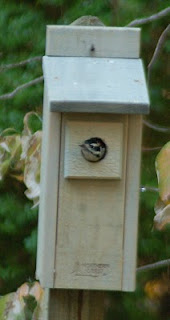Why it's Mr. Downy Woodpecker! He was also hard at work improving the size of the Bluebird Box entrance hole to suit his frame. See the sequence of events fold here.
First, he drummed and drummed until he made the hole large enough for him to get in. Once in, he had to drum and drum from the inside until he could get out!
 He did get out, after several tries, and then went next door to the feeder station to grab a bite.
He did get out, after several tries, and then went next door to the feeder station to grab a bite.He's been gone now for about an hour. I wonder if he'll be back?
According to Cornell's Lab of Ornithology, woodpeckers don't have a song, so their drumming may be the behavior they use to let others know the bounds of their territory.
He probably wasn't checking out the box in order to nest. Downies only have one brood and breeding season is usually from February to July.
A Bluebird expert says he's never seen a Downy nest in a nest box, but that they do roost there. I'll be watching just before dusk!

A Collection of Downy Woodpecker Facts
from Sialis
- The Downy is the smallest North American woodpecker, and the most common (based on BBS and CBC data.)
- Their tongue is coated with sticky mucus to help nab small insects.
- When drumming, Downies hit the substrate about 16-17 times per second. Drumming can last 0.25-1.8 seconds. (Ritchison). They primarily drum from Feb-July.
- Downies are rarely seen bathing in water, although they have been seen "snowbathing." (Merriam 1920)
- Downies may excavate for a few minutes up to an hour, usually working 15-20 minutes at a time.
- Both parents incubate and brood (only males incubate and brood at night.)
- In nonbreeding season, downies will hang in mixed flocks of chickadees, titmice, nuthatches, kinglets and Hairy Woodpeckers, and respond to alarm calls by chickadee or titmice sentinels.
- On cold winter nights, Chickadees and Downy Woodpeckers conserve energy by lowering their body temperature by 10 to 15 degrees F. While this may seem counterproductive, “nocturnal hypothermia” probably reduces energy expenditure by as much as ten percent.
- Males forage more on smaller branches, females on larger branches and tree trunks.
- They occasionally drink sap and eat cambium, but the holes they make are smaller, less rectangular, and less deep than sapsuckers, so they do not injure the tree.
- They have been seen following White-breasted nuthatches and stealing from their food caches (Sutton 1986).



No comments:
Post a Comment